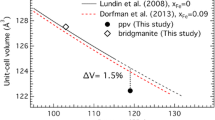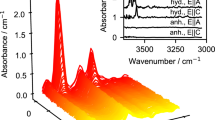Abstract
Experimental evidence is reported for Fe2+ disproportionation in Al-free perovskite (Pv), when submitted to large temperature gradients (i.e., under off-equilibrium conditions) in a laser heated diamond anvil cell (LHDAC). To enable this effect, the experimental procedure was designed to produce large radial and axial temperature gradients. In the Pv and ferropericlase (Fp) assemblage synthesized after dissociation of natural olivine, the three chemical states of iron (i.e., Fe0, Fe2+ and Fe3+) could be evidenced by electron probe microanalysis (EPMA), through variations of oxygen contents attached to the Fe cations. Despite inherent difficulties for determination of O-contents and Fe3+/ΣFe ratios using EPMA, we recorded significant changes in iron oxidation state across the laser-heated strip. These changes are correlated with variations in composition for the major elements (Fe, Mg, and Si), which evidences that the Pv/Fp assemblage experienced large segregation under the strong temperature gradients. Grains of metallic iron were detected in parts of the laser-heated strip coexisting with a Pv phase with Fe/(Mg + Fe) = 6 at% and most of its iron as Fe3+. This Fe2+-disproportionation reaction involves insertion of Fe3+-defects in the Pv lattice. This Fe3+-bearing Pv phase is presumably unstable and decomposes into a mineral assemblage including magnesioferrite, which is detected at the border of the laser-heated strip.






Similar content being viewed by others
References
Andrault D, Bolfan-Casanova N (2001) High-pressure phase transformations in the MgFe2O4 and Fe2O3-MgSiO3 systems. Phys Chem Miner 28:211–217
Andrault D, Bolfan-Casanova N, Bouhifd MA, Guignot N, Kawamoto T (2007) The role of Al-defects on the equation of state of Al-(Mg,Fe)SiO3 perovskite. Earth Planet Sci Lett 263:167–179
Aquilon: http://www.trefle.u-bordeaux1.fr/index.html?/aquilon/index.html
Auzende AL, Badro J, Ryerson FJ, Weber PK, Fallon SJ, Addad A, Siebert J, Fiquet G (2008) Element partitioning between magnesium silicate perovskite and ferropericlase: new insights into bulk lower-mantle geochemistry. Earth Planet Sci Lett 269:164–174
Ballhaus C, Berry RF, Green DH (1991) High pressure experimental calibration of the olivine-orthopyroxene-spinel oxygen geobarometer: implications for the oxidation state of the upper mantle. Contrib Mineral Petrol 78:27–40
Bastin GF, Heijligers HJM (1989) Quantitative electron probe microanalysis of oxygen. Internal report, Eindhoven University of Technology (ISBN 90-6819-012-1)
Bell PM, Mao HK (1975) Preliminary evidence of disproportionation of ferrous iron in silicates at high pressures and temperatures. Carnegie Institution Washington Year Book, 74: 557–559
Bell PM, Mao HK, Weeks RA, Valkenburg AV (1976) High pressure disproportionation study of iron in synthetic basalt glass. Carnegie Institution Washington Year Book 75: 515–520
Bodea S, Jeanloz R (1989) Model calculations of the temperature distribution in the laser-heated diamond cell. J Appl Phys 65(12):4688–4692
Brodholt JP (2000) Pressure-induced changes in the compression mechanism of aluminous perovskite in the Earth’s mantle. Nature 407:620–622
Campbell AJ, Heinz DL, Davis AM (1992) Material transport in laser-heated diamond anvil cell melting experiments. J Geophys Res B19:1069
Casino (2000) for Windows-based PC in free access on the web: http://www.gel.usherbrooke.ca/casino/index.html
Duba A, Peyronneau J, Visocekas F, Poirier JP (1997) Electrical conductivity of magnesiowüstite/perovskite produced by laser heating of synthetic olivine in the diamond anvil cell. J Geophys Res 102(B12):27723–27728
Heinrich KFJ, Newbury DE (eds) (1991) Electron probe quantitation. Plenum Press, New York
Fialin M, Rémond G (1993) Electron probe microanalysis of oxygen in strongly insulating oxides. Microbeam Anal 2:179–189
Fialin M, Rémond G, Bonnelle C (1994) New developments in electron probe microanalysis of oxygen in wide bandgap oxides. Microbeam Analy 3:211–224
Fialin M, Wagner C, Métrich N, Humler E, Galoisy L, Bézos A (2001) Fe3+/ΣFe versus Fe Lα peak energy for minerals and glasses: recent advances with the electron microprobe. Am Mineral 86:456–465
Fialin M, Bézos A, Wagner C, Magnien V, Humler E (2004) Quantitative electron microprobe analysis of Fe3+/ΣFe: basic concepts and experimental protocol for glasses. Am Mineral 89:654–662
Frost DJ, Langenhorst F (2002) The effect of Al2O3 on Fe–Mg partitioning between magnesiowüstite and magnesium silicate perovskite. Earth Planet Sci Lett 199:227–241
Frost DJ, Liebske C, Langenhorst F, McCammon C, Tronnes RG, Rubie DC (2004) Experimental evidence of iron-rich metal in the Earth’s lower mantle. Nature 428:409–412
Fujino K, Miyajima N, Yagi T, Kondo T, Funamori N. (1998) Analytical electron microscopy of the garnet-perovskite transformation in a laser heated diamond anvil cell, properties of earth and planetary materials at high pressure and temperature. Geophysical Monograph, pp 409–417
Geller JD, Engle PD (2002) Sample preparation for electron probe microanalysis: pushing the limits. J Res Natl Inst Stand Technol 107(6):627–638
Gessmann CK, Wood BJ, Rubie DC, Kilburn MR (2001) Solubility of silicon in liquid metal at high pressure: implications for the composition of the Earth’s core. Earth Planet Sci Lett 184:367–376
Gloter A, Guyot F, Martinez I, Colliex C (2000) Electron energy-loss spectroscopy of silicate perovskite-magnesiowüstite high-pressure assemblages. Am Mineral 85:1452–1458
Guyot F, Madon M, Peyronneau J, Poirier JP (1988) X-ray microanalysis of high pressure/high temperature phases synthesised from natural olivine in a diamond anvil cell. Earth Planet Sci Lett 90:52–64
Heinz DL, Sweeney JS, Miller P (1991) A laser heating system that stabilizes and controls the temperature: diamond anvil cell applications. Rev Sci Instrum 62(6):1568–1575
Lauterbach S, McCammon CA, van Aken P, Langenhorst F, Seifert F (2000) Mössbauer and ELNES spectroscopy of (Mg, Fe)(Si, Al)O3 perovskite: a highly oxidised component of the lower mantle. Contrib Mineral Petrol 138:17–26
Luth R, Virgo D, Boyd FR, Wood BJ (1990) Ferric iron in mantle derived garnet: implications for thermobarometry and the oxidation state of the mantle. Contrib Mineral Petrol 104:56–72
Manga M, Jeanloz R (1996) Axial temperature gradients in dielectric samples in the laser-heated diamond cell. Geophys Res Lett 23(14):1845–1848
Manga M, Jeanloz R (1998) Temperature distribution in the laser-heated diamond cell: properties of earth and planetary materials at high pressure and temperature. Geophysical monograph 101
McCammon CA (1997) Perovskite as a possible sink for ferric iron in the lower mantle. Nature 287:694–696
McCammon CA (1998) The crystal chemistry of ferric iron in Fe0.05Mg0.95SiO3 perovskite as determined by Mössbauer spectroscopy in the temperature range 80–293 K. Phys Chem Mineral 25–4:292–300
O’Neill HStC, Wall VJ (1987) The olivine-orthopyroxene-spinel oxygen geobarometer, the nickel precipitation curve, and the oxygen fugacity of the Earth’s upper mantle. J Petrol 28:1169–1191
O’Neill HStC, McCammon CA, Canil D, Rubie DC, Ross FII, Seifert F (1993) Mössbauer spectroscopy of mantle transition zone phases and determination of minimum Fe3+ content. Am Mineral 78:456–460
Peyronneau J, Madon M, Poirier JP (1984) Indirect pressure measurements in diamond anvil cell up to 1 megabar. J Phys 45:403
Pouchou JL, Pichoir F (1988) Determination of mass absorption coefficients for soft X rays by use of the electron microprobe. In: Newbury DE (ed) Microbeam analysis. San Francisco Press, San Francisco, pp 319–324
Pouchou JL, Pichoir F (1991) Quantitative analysis of homogeneous or stratified microvolumes applying the model “PAP”. In: Heinrich KFJ and Newbury DE (eds) Electron probe quantitation. Plenum Press, New York, pp 31–75
Rouquette J, Dolejš D, Kantor IYu, McCammon CA, Frost DJ, Prakapenka VB, Dubrovinsky LS (2008) Iron-carbon interactions at high temperatures and pressures. Appl Phys Lett 92:121912
Sweatman TR, Long JVP (1969) Quantitative electron-probe microanalysis of rock-forming minerals. J Petrol 10(2):332–379
Xu Y, McCammon C, Brent TP (1998) The effect of alumina on the electrical conductivity of silicate perovskite. Science 282:922–924
Yamazaki D, Kato T, Yurimoto H, Ohtani E, Toriumi M (2000) Silicon self-diffusion in MgSiO3 perovskite at 25 GPa. Phys Earth Planet Interior 119(3–4):299–309
Author information
Authors and Affiliations
Corresponding author
Appendix: Criteria for selecting the plots of Fig. 6
Appendix: Criteria for selecting the plots of Fig. 6
A two stage protocol has been established to discard EPMA data affected by topographical effects due to the non-flatness of the sample surface and the presence of voids and cracks onto: (1) analytical wt%-totals, including measured oxygen content, should be encompassed within the interval delimited by the wt%-totals with oxygen calculated by stoichiometry of the measured cations, with Fe oxide as FeO (lower limit), and the same with Fe oxide as Fe2O3 (upper limit) (Fig. 7a); (2) the wt%-total values that are calculated to be different by more than 1wt% compared to the mean wt%-total value for the whole sample are discarded (Fig. 7b). The selected plots encompassed within the regions, where vertical hatched bands overlap the horizontal band (Fig. 7b). We observe that no data were selected for the first part of the line scan, due to underestimated oxygen content correlated presumably with a round-shaped surface in contact with epoxy. We also note that the region corresponding to the open symbols (Fig. 7a) is to be discarded. Nevertheless, they were selected as a record of the presence of the metallic phase forming the peak #1 region of the line scan.
a Differences in the wt%-totals as deduced from analyses with oxygen either measured or calculated by stoichiometry of the measured cations. Diamonds with oxygen attached to iron as Fe2+, squares with oxygen attached to iron as Fe3+. Hatched area delimit the regions of the linescan where plots have undergone a first selection to construct Fig. 6 (see text). Open symbols presence of a metallic phase (Fe0) and should not be discarded. b Final selection for plots exhibiting wt%-totals lying between 96 and 98%. Vertical hatched regions are the same as (a)
Rights and permissions
About this article
Cite this article
Fialin, M., Catillon, G. & Andrault, D. Disproportionation of Fe2+ in Al-free silicate perovskite in the laser heated diamond anvil cell as recorded by electron probe microanalysis of oxygen. Phys Chem Minerals 36, 183–191 (2009). https://doi.org/10.1007/s00269-008-0268-9
Received:
Accepted:
Published:
Issue Date:
DOI: https://doi.org/10.1007/s00269-008-0268-9





